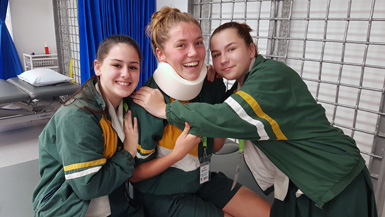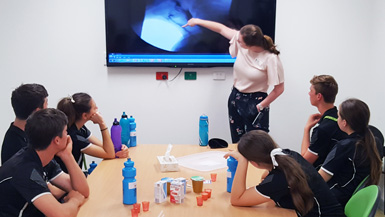Testimonials
Feedback from students, teachers and parents who have attended P.A.R.T.Y. programs.
- It really gives people an insight to make the right choices- and the consequences for their actions (student).
- Great idea - all school students need to hear this (teacher).
- The confronting pictures and interactive activities were the best because they really showed and taught you what can happen if you make the wrong decision (student).
- The stories about real people and what happened to them were sad and confronting but still left its mark (student).
- Great for young people to learn "It can happen to me" (parent).
The following article was written by a student from one of the participating schools. It first appeared in the school newsletter on May 17 and is reproduced here with the author's permission.
Prevention of Alcohol and Risk Related Trauma in Youth
Royal Brisbane Women's Hospital
P.A.R.T.Y PROGRAM
A student perspective…
A huge thank you is owed to the PARTY program - it was not only educational, but it had an extreme impact on the students and staff who attended.
In the lead up to going into the PARTY program, I honestly wasn't expecting much. Everyone has been on the average hospital excursion and nothing really resonates with you. You go, people spend the time telling you what you shouldn't do and you don't end up seeing much. Furthermore, I went into the program thinking the focus would revolve around binge drinking, given the topic of our current Year 12 Health Education assessment piece.
I can tell you now, as I reflect on the experience that I was wrong in so many ways and ultimately, was not prepared at all for the Program or the way it would eventually affect me.
When we arrived there were a line of emergency paramedics chatting casually outside. Here we go - I thought - just another boring day of people throwing facts at you; yet another death by PowerPoint situation. On top of that, hospitals have always made me uncomfortable; the sterile smell, the long halls, which seem maze like, with the floors that stick to your feet and the lights that seems to buzz and flicker ominously in every ward. The general hopeless feel of the place – it’s fair to say that I don’t like hospitals.
I was relieved when we were shuffled into an auditorium and the P.A.R.T.Y Program began. We are given the customary introduction; what we will be doing over the course of the day, who the key people are, our groups and of course where the fire exits are in case of emergency. Then we're told that the Emergency Ward is off limits as it's too busy. It’s explained to us that with rain as heavy as we had experienced the night before – the number of emergency admissions increases exponentially. It's barely 10 am and already the Emergency Ward is already under the pump.
Despite all of this, my first impression however, is that I love the PARTY staff. No time is wasted; a presentation is given by an emergency paramedic and then we’re quickly moved out to experience some ‘hands on’ activities. We're putting on glasses – beer goggles if you like, with each pair of glasses rated at a different B.A.C level. We’re told to walk in a straight line, I think it's going to be easy – how wrong I was. I nearly fall over – the impact of the glasses is incredible – we’re all disoriented, unbalanced and unable to stay focused on anything. We have to unlock a door, walk in a straight line and kick a ball. While it was extremely hilarious, I can't help but think, "Geeze, people drive like this"
We have some lunch and then watch a facial reconstruction presentation and I cringe at every slide. It is graphic and it is gruesome. Each photo is of someone who has experienced severe head trauma – and we see everything, from the before shots of admission into the Emergency Department, to the surgery shots – where we see the surgeons in the process of putting someone’s face back together again and to the after shots – of people who are in the long process of recovering. It showed the aftermath of risk taking behaviours, such as the coward punch and the long term health effects. It is devastating to see injuries which are caused by risk taking behaviours – because it is all preventable.
Next we get back into our group and are shuffled into a lift. We're going to the ICU and I just catch what one of our guides say, she looks down, "this is going to be sad". Walking through the hospital I catch glimpses of patients, I look at my feet out of respect, but part of me feels like I'm not treating them like real people. I wonder why illness and sickness becomes the definition of people. Why do we allow illness to begin to cultivate other people’s identity and why are we so afraid or is it ashamed to look past the illness and see the individual?
We go into the ICU and there's a dummy lying on a bed hooked up to tubes. We sit down. I hated everything about that room and in a way, I felt that the dummy was dehumanising.
This is because real people have died in places like this. Someone in my family had died while hooked up to the same machines in a room as lifeless as the one we were in. However, my anger dissipates into sadness when a mother - Wendy - speaks to our group about her daughter - Lauren and she speaks of Lauren’s organ donation. Lauren was our age when she died, only 17 years old, a passenger in a car crash – driven by a friend.
She placed a picture of her daughter on the table next to me and I feel ready to fall apart. I was taken off guard, "I don't ever want to end up like that" I think. But, we soon learn from Wendy’s story, that this can happen to anyone – this could be anyone’s story. When Wendy finishes and asks us if we have any questions – no one is able to speak. She quietly says to us that no one ever has any questions and it’s heartbreaking to hear the grief in her voice.
Everyone is emotional; the ICU touched us all in different ways. Whether someone we loved was hit by a car, taken by cancer or was involved in an accident, this session has hit us all – the despair in the room is palpable – it’s all so real.
We went through other presentations, most of them made us giggle, but most importantly, they all showed us first-hand, what risk taking behaviours can result in; whether that's losing an arm or worse – as Wendy and Lauren’s story showed us.
I'm feeling better and then we walk into a room that looks a lot like the ICU. We all have to put on yellow plastic surgical gowns and gloves. There's a small stretcher in the middle of the room with a blanket on it and the shape of a body underneath. I stay towards the back. A man, a doctor who trains students on prac at the hospital, starts talking to us about the simulation and suddenly he's interrupted by a phone call.
He tells us that there has been a serious incident involving a Noosa District student. A boy, texting on his phone has been hit by a car travelling at 80km/hr – the boy didn’t even look up to cross. We are all in shock, again, it hits us how can easily these traumas can happen – and we believe it has happened to one of us, someone from our community. No one can speak, we’re looking at each other unsure of how to react.
Then he reveals a dummy beneath the blanket. This is the young boy, who's been hit by a car. And just like that, we’re thrown into an emergency response simulation.
We work on the dummy attempting to save him. We place in IV lines, hook in new blood, we use a defibrillator, we apply CPR, we pump adrenaline into his body to try and improve his heart readings. There's no progress, the Doctor asks us if we wish to continue or give up. I say yes every time, but as we reach 90 minutes of trying to resuscitate this young man, the group decides there’s no way to revive him. We essentially made the decision to stop trying to save this person’s life. Again – the reality of this scenario hits us. This is was the hospital staff has to deal with every day. It’s devastating, it’s exhausting and it’s a life or death situation where the team has to make the call.
I think everyone needs to go through something like that to fully understand the effects of risk taking behaviours. It was so confronting and I felt so drained afterwards. I hated having to give up on someone.
Despite the fact that I felt drained, on my way home the impact of the day really settles with me and I think that is a success in itself. To have this profound impact on someone, is one step closer to a positive change, to preventative behaviours which could possibly save a life.
Imagine a world where we didn't normalise these incidents; a world where we don’t glorify risk taking behaviours and ignore the consequences. Imagine a world where we all understood. And so I say thank you to the PARTY program, for making an impact and a difference.
~ Rose, Year 12.


